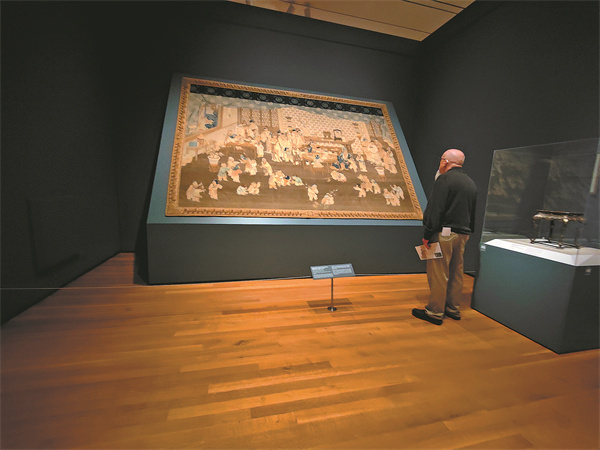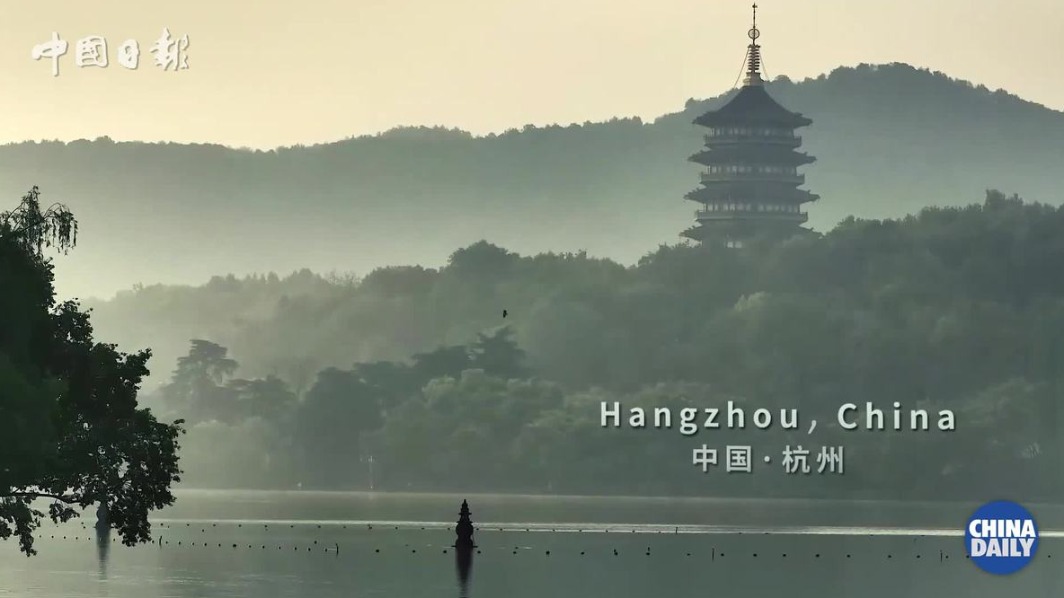home is where the art is

one exhibit stands out from the ongoing exhibition china's southern paradise: treasures from the lower yangzi delta, on view at the cleveland museum of art. it is a map — a rubbing to be exact — of china's earliest surviving city plan to have been engraved on a stone slab. within an area of 5 square meters, the rubbing, created in the first half of the 20th century, depicts modern-day suzhou, featuring six water gates and more than 300 bridges, validating the city's entitlement to the name "venice of the east".
for centuries up to the point when the map was made, suzhou had acted as a commercial center of jiangnan, the term denoting the southern part of the lower yangtze river delta, the region examined by the exhibition at the cma.
and for people who have traced the region's history to antiquity, the concept of water gates is anything but new. back in around 3000 bc, the ancient people of liangzhu, who first realized the potential of the land, erected on it a grand city, before furnishing the inner city walls with eight water gates — two on each side — to facilitate transportation conducted over a dense network made up of both natural and man-made waterways.
today, what remains of liangzhu city still evokes the heroic efforts involved in turning this place into a home, including building stilt houses, digging aqueducts and cultivating acres of swampy land to grow domesticated rice, whose carbonized form can still be seen today.
"the water element provides an undercurrent to the storytelling of jiangnan," says wang ningyuan, who has led the excavation at what's known today as the archaeological ruins of liangzhu city, a unesco world heritage site.
judging by what has been discovered from the waterlogged underground silts, the ancient liangzhu people traveled on flat wooden rafts, measuring at about 0.5 meters wide and 2 meters long. they probably still did when yue jue shu (the book of yue) was compiled somewhere between the 1st and 3rd centuries, in which it was rightfully noted that "the yue people (from the south) tamed boats the same way the hu people (from the north) tamed horses".
here, yue refers to the ancient state of yue, whose prolonged war with its neighbor, the state of wu, fought between the late 6th century bc and mid-5th century bc, is well-chronicled. for some time, the two occupied the jiangnan area, which explains why the region is traditionally referred to as "the land of wu and yue". after wu's total defeat in 473 bc, the rulers of yue decided to move their power base to the former capital of wu — the city of suzhou.
according to yang haitao, a veteran researcher from the nanjing museum, despite commonly held beliefs, jiangnan during the time of wu and yue had interacted frequently with the land to their immediate north, land long considered to be the sole birthplace of the chinese civilization before historians were persuaded by overwhelming archaeological evidence to greatly modify their conclusions.
"bronze swords and mirrors with intricate patterns were produced in relatively large numbers in jiangnan around this time, testifying to the spreading into the region of metallurgical know-how from the north, where it had been put to the creation of magnificent, bewilderingly complex ritual bronze ware," says yang.
the exhibition features an ox-shaped bronze lamp on loan from the nanjing museum, located in the jiangnan city of nanjing, 200 kilometers from suzhou. opulently patterned and ingeniously designed — when in use, the smoke and soot resulting from burning fuel is channeled through a connecting pipe into the animal's water-filled body — the lamp was believed to have been locally made between the 1st and 3rd centuries.
"you can tell the story of jiangnan through craftsmanship," says the exhibition's curator clarissa von spee, pointing to the fact that the region, during the entire qing dynasty (1644-1911), had served as the single largest base for china's handicraft industry, with the city of yangzhou noted for its mirror production.
outside influences
apart from tradition, the several waves of immigration that had rushed over the land of jiangnan over the course of history also contributed to the phenomenon, according to von spee. "increased population density intensified competition, and competition breeds excellence," she says.
in the case of jiangnan, that excellence has often taken the form of exquisiteness, achieved at the cost of time-consuming labor. to prove it, von spee includes in the exhibition a bamboo vest made up of an estimated 3,490 fine bamboo tubes, each measuring about 5 millimeters long.
"these were typically worn by officials, who were men, as undershirts to prevent the soiling of their court robes in the sweltering jiangnan weather," says the curator. "strung together by cotton threads, the tubes are hollow inside. yet i cannot imagine a bamboo of that thinness having already developed a wooden texture."
"therefore, there's only one possibility: whoever responsible for making of this vest, sometime around the 17th century, must have hollowed out bamboo wood to create these tiny tubes," says von spee, noting that her decision to highlight the vest, which entered the museum's collection back in 1918, was also driven by the significance of bamboo to the literati culture of jiangnan.
the plant, "growing so abundantly in the lower yangtze delta" to use her words, had long been admired for its sturdy flexibility, which made it a symbol of resilience in times of adversity.
at the exhibition, the image of the plant appears on a 12th-century gilded silver tea service set, together with those of birds, butterflies and blossoms — all favorite subjects of jiangnan artists. according to historical documents, tea shops in hangzhou, the southern song capital between 1127 and 1279, would sell ice-cold plum-blossom drinks in silver vessels during the summer.
the kind of beauty jiangnan had embraced and embodied was a sophisticated one, informed by an elegant lifestyle championed by society's educated members. playing a major role in the formation of the aesthetic and literary traditions of jiangnan, this group infused their endeavors with a sense of poetry.
one particular exhibit drenched in that tradition is a rubbing made of a piece of prose carved into a cliff face in the jiangnan town of zhenjiang, between the 5th and 6th centuries. the original calligraphy, on which the carving was based, is attributed by some scholars to tao hongjing (456-536), a calligrapher-alchemist who was also a devoted taoist.
in the article of 168 characters, titled yi he ming (eulogy to the burial of a crane), the author laments, "did heaven not allow me to roam the cosmos as i wish? why take away my crane so quickly?"
held in high esteem for its calligraphic and literary value, the carving, now housed in a local museum, has spawned many different versions of rubbing over time, including the one on display at the exhibition, made during the qing dynasty (1644-1911) and currently within the collection of the nanjing museum.
"some versions contain more words, some fewer — the cliff face was half immersed in water and the changing water levels may reveal or conceal part of the piece," says yang.
in other words, water had a role to play in the artistic process, as it has often been in this part of china.
according to yang, the prose, from a taoist believer about an animal considered a taoist symbol of immortality, could be rightfully viewed as a piece of religious art. throughout a large part of the history of jiangnan, taoism and buddhism coexisted in harmony.
"when the ancient chinese philosopher zhuangzi talked in his writings about 'the uncivilized land in the far south', he was certainly thinking about the region beyond the yangtze river," says von spee. "he saw the land as not being governed by confucian rules and rituals, which, he believed, was something positive, since it allowed people to follow the rules of nature, the only rules that should be followed according to taoist teachings."
zhuangzi (chuang-tzu) lived between the 4th and 3rd centuries bc. in the ensuing two millennia, confucianism did become the guiding ideology of chinese society, and jiangnan, its stronghold. but the influence of taoism and buddhism, having long seeped into the social fabric, never stopped permeating local life and culture.
as a result, jiangnan was simultaneously at the center and on the margin. it was a cultural and commercial hub that also constituted a getaway in the common imagination.
"inclusiveness — that's what jiangnan as a land for immigrants was all about," she says.
gardens of the soul
in fact, that inclusiveness was written in the genes of jiangnan. in 515 bc, he lyu ascended to the throne of the state of wu and immediately started the construction of a grand city on the land of modern-day suzhou. it was a project that would announce his ambition and anticipate, in retrospect, all the splendor that would befall the city. and the king entrusted it to a man named wu zixu, who had come to his aid from the king's archrival, the state of chu.
another "foreigner" whose help he lyu had enlisted was sun wu (sunzi), originally from the state of qi, who trained the king's army to be invincible, before summing up his military strategies in the ageless text the art of war.
he lyu died in 496 bc due to wounds he had sustained during a military campaign against the state of yue, another of wu's long-standing enemies. he was succeeded by his son, who initially triumphed over yue, but was ultimately defeated in 473 bc. with the state of wu ceasing to exist, the region's map was redrawn, once again.
the exhibition had a bronze mirror minted more than half a millennium later, during china's eastern han dynasty (25-220), that illustrates the wu-yue saga, featuring its major characters.
the need for survival demanded open-mindedness, which later served the jiangnan society well, as it started to put greater emphasis on commerce and education. "from free markets to a sense of freedom intrinsic to literary pursuits, that spirit really provided jiangnan with its lasting momentum," says yang.
it is estimated that during the ming dynasty (1368-1644), more than 16 percent of all those who had passed the court examinations and were poised to enter bureaucracy were from the jiangnan region. (also during this time, jiangnan became a national center for publishing and woodblock printing.)
one of them was the legendary artist-art theorist dong qichang (1555-1636) whose works and writings shaped literati aesthetics for the next 300 years. during his stay in beijing, the ming capital, dong created a painted album for a friend who, toward the end of his office, was heading back home to huating (modern-day shanghai), also dong's hometown.
one leaf from the album, exhibited at the exhibition on loan from the shanghai museum, is beguilingly titled west lake. instead of showing a view of hangzhou's iconic scenic spot, this one depicts the rather more anonymous west lake, situated in the hills to the west of beijing. what was going through dong's mind while working on this summer view is unquestionable.
"when a jiangnan native was appointed to office elsewhere, they took with them the region's cultural traditions and memories," yang says. or, they may even try to re-create a miniature version of jiangnan in their own backyard, whether they were in or outside of the region. it was especially true during the ming and qing dynasties, the heydays of garden building in jiangnan.
"a jiangnan garden, complete with man-made mountains and lakes, was a condensed, manicured version of the landscape and a world unto itself, where one could, presumably, be intimate with nature and be free," says yang.
so the idea was: no matter where you were and how elevated you became socially, you need bamboo groves to recline in and fish ponds to gaze upon.
let sima guang (1019-86), a northern song (960-1127) period statesman, tell you. the man, after retirement, built a garden for himself that would become so famous that half a millennium later it lent its name — garden for solitary enjoyment — to a ming-dynasty painting, which in turn became the template for numerous suzhou workshop copies.
"i channel streams to water flowers, or trim bamboo," sima wrote. "i know of no joy between heaven and earth that could take its place."
-
'nice' to meet you, hangzhou
may 6, 2024

